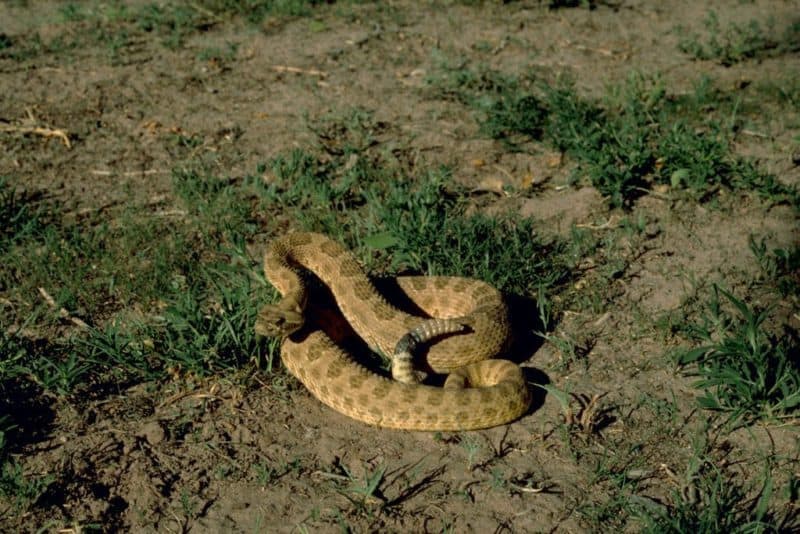The Prairie Rattlesnake (Crotalus viridis) is the only species of venomous snakes in North Dakota. Prairie Rattlesnakes are valuable members of the ecosystems that they live in due to the fact that they help keep rodents and other small mammal populations in check. These reptiles pose a potential threat to humans, though. In an average year, around 5 people are bitten by Prairie Rattlesnakes in North Dakota.
This guide will tell you where to find these venomous snakes in North Dakota. We’ll also inform you more about Prairie Rattlesnake’s characteristics and behaviors. Finally, we’ll tell you how to coexist with them as safely as possible in North Dakota’s outdoors.
Pit Vipers: The Venomous Masters of Infrared Detection
Since North Dakota’s Prairie Rattlesnakes are pit vipers, let’s learn a little bit about them.
Rattlesnakes, Copperheads, and Cottonmouths are among the members of the Crotalinae subfamily of the Viperidae family of venomous snakes, also referred to as pit vipers. These snakes are equipped with unique adaptations that make them exceptional hunters.
What Makes Pit Vipers Unique?
- Infrared-Sensing Pits:
A defining feature of pit vipers is the deep facial pit between their nostril and the eye on each side of their head. These specialized infrared-detecting organs allow pit vipers to sense heat emitted by prey. This adaptation enables them to:- Detect body heat from up to 1 meter away.
- Strike prey with pinpoint accuracy, even in complete darkness.
- Triangular Heads and Vertical Pupils:
- Head Shape: Pit vipers are recognized by their distinct triangular-shaped heads, which house their venom glands.
- Eyes: They have vertical elliptical-shaped pupils.
- Venomous Fangs:
Pit vipers have hollow fangs connected to venom glands. These fangs fold back against the roof of their mouth when not in use.
Ecological Importance
Pit vipers serve as a check to rodent populations. Despite their fearsome reputation, these snakes are vital to the health of many habitats.
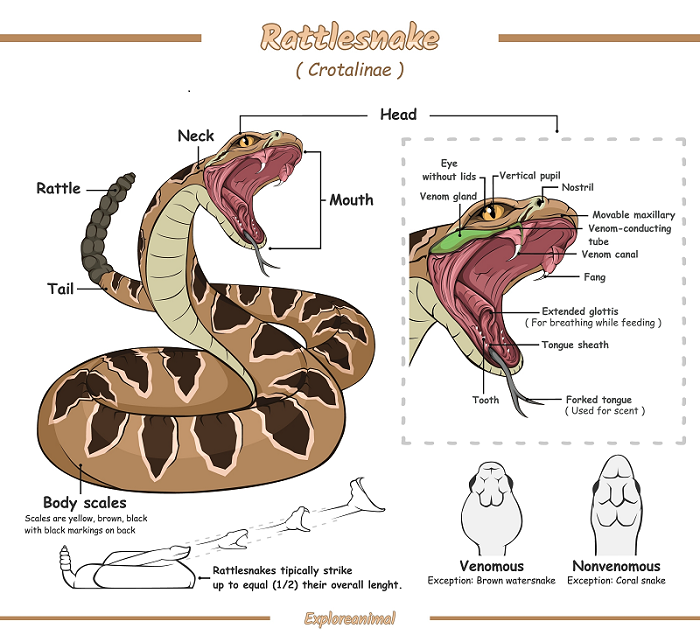
Rattlesnakes in North Dakota
What North Dakota’s rattlesnakes have in common with most other rattlesnake species is their rattle.
- Most rattlesnakes have a rattle at their tail’s end, comprised of hollow, loosely interlocked keratinous scales.
- Normally, a rattlesnake adds a new segment to its rattle each time it sheds its skin.
- An agitated rattlesnake rapidly vibrates its tail, causing the segments of its rattle to vibrate together, creating a buzzing or rattling sound.
- Not all rattlesnakes rattle before they strike. Sometimes, they lose their rattles due to injury, and sometimes, they choose not to rattle.
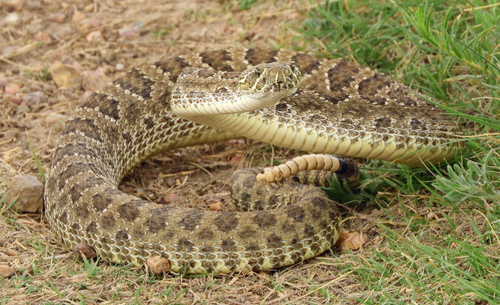
Prairie Rattlesnake (Crotalus viridis)
What Do Prairie Rattlesnakes Look Like?
| Size | *Adults typically measure about 3.3 feet (100 cm) in length. *The longest recorded specimen was just under 5 feet (151.5 cm) long. |
| Coloration | *Their base color varies and can be tan, olive green, or brown. |
| Dorsal Spots | *Brown blotches with darker borders are present on their bodies. |
| Head | *They have a triangular-shaped head with pit sensory organs on either side. *A light stripe runs diagonally from the back of each eye to the jaw. *Another stripe extends diagonally from below the eye to the corner of the mouth |
| Behavior | *Primarily ground-dwelling but occasionally climbs shrubs, bushes, or trees. |
| Conservation Status | *Common within their range in North Dakota. |
Prairie Rattlesnakes are ambush predators. This means they will sit and wait until their prey comes by before striking. They use their pit organs and tongues to sense their prey.
All snakes, including prairie rattlesnakes, flick their tongues to smell the air. They are able to pick up tiny chemical particles that help them zero in on their prey.
Newborn rattlesnakes are born with one keratin segment at the end of their tail. They grow a new segment each time they shed their skin. They will typically gain 2-3 segments each year.
Baby rattlesnakes are born with fully functioning fangs and can envenomate their prey. Adult rattlesnakes shed their fangs every 6-10 weeks. They have three pairs of replacement fangs waiting behind their functioning pair.
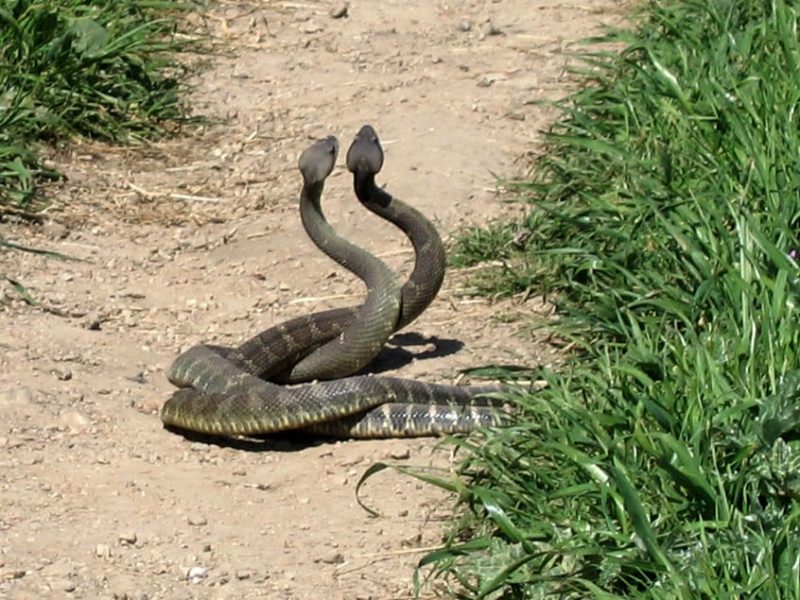
Prairie Rattlesnake Behavior
In North Dakota, prairie rattlesnake season is mainly from April to October. They spend the coldest winter days brumating in underground dens.
Bumation is a reptile’s version of hibernation. Prairie Rattlesnakes brumate in communal dens. But their hunting grounds extend as far as seven miles from their dens in the summertime. In the warmer months, prairie rattlers might shelter in old mammal burrows. But in the fall, they will return to their communal dens.
Prairie Rattlesnake dens are generally located on south-facing slopes. Southerly slopes receive more direct sunlight. Rocky areas are more likely to have cavities or fissures that snakes use to den in.
These snakes mate in the late spring and early summer. Male Prairie Rattlesnakes participate in combat rituals. They do this for the right to mate with receptive females. When they do this, they face each other with their heads and part of their bodies elevated off the ground. They then intertwine and attempt to knock each other to the ground. The snake that doesn’t get knocked to the ground wins breeding privileges.
Pregnant female Prairie Rattlesnakes give birth to 8 to 17 babies in late summer. Like the majority of pit vipers, rattlesnakes are viviparous. This means that they give live birth rather than laying eggs.
Baby Prairie Rattlesnakes are born fully equipped to take care of themselves. They are on their own after a few days.
Can You Determine Rattlesnake Age by the Segments of Its Rattle?
It is a widespread belief that the number of segments in a rattlesnake’s rattle determines its age. But this isn’t true. They grow a new segment each time they shed their skin. Young rattlesnakes do this more often than older rattlesnakes. Their end segments regularly break off with day-to-day activity. So there for the number of segments on the snake’s tail does not indicate the rattlesnake’s age.
Read more about 25 Interesting Rattlesnake Facts .
Where Are Prairie Rattlesnakes Found in North Dakota?
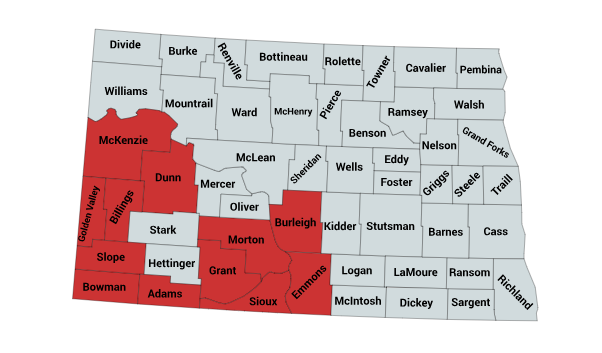
Prairie rattlesnakes inhabit every county west and south of the Missouri River. Prairie rattlers are less common on the eastern side of the Missouri River. They are there, though. Observers have noted their presence in Burleigh and Emmons counties.
Prairie rattlesnakes inhabit a variety of habitats throughout their range. True to their name, they favor prairies and open grasslands. They also live in wooded areas such as the deciduous forests of the Turtle Mountains. They are more likely to be located in or near rocky outcrops or prairie dog towns.
Matthew Smith is a Biological Sciences associate professor at North Dakota State University. He has been monitoring a population of Emmons County Prairie Rattlesnakes since 2015. This dispels the rumor that there are no rattlesnakes east of the Missouri River.
Smith has located a Prairie Rattlesnake den in the hills overlooking the river. Smith and a team of North Dakota Game and Fish Department personnel go back to the site once a year. They then check on the rattlesnakes there. The most snakes that they have found there is 22.
According to Smith, the male snakes at this site are larger than the ones he tends to see on the western side of the river. Also, the females were mostly all in good body condition. This means that they are receiving adequate nutrition on the eastern side of the river.
What Do Prairie Rattlers Eat?
A Prairie rattlesnake’s favorite food is small mammals. Accordingly, mice, rats, rabbits, ground squirrels, and prairie dogs are on their menu. They will also eat ground-nesting birds and occasionally small amphibians and reptiles.
Most people are afraid of all types of snakes. But left alone, they benefit our ecosystem by reducing rodent populations.
How Dangerous Are Prairie Rattlesnakes?
Prairie rattler venom is a mix of hemotoxins and mycotoxins. Furthermore, according to some literature, it also has neurotoxins.
Prairie rattlesnake bites can have serious effects. The venom can cause severe pain. It may also induce shock, making the victim feel weak and disoriented. Swelling, blistering, and inflammation can occur at the bite site. Their hemotoxic venom can also damage red blood cells and impair blood clotting. On the other hand, myotoxic venom contains digestive enzymes that destroy body tissue. In severe cases, the bite may result in severe tissue damage. There is also a risk of harm to internal organs. Source
Brian Smith is a biologist and associate professor at Black Hills State University. He specializes in the study of snakes and snake venom. According to Smith, prairie rattlesnakes would just as soon leave people alone. He says some bites occur when people find a rattlesnake and won’t leave it alone. Other times, bites occur when someone stumbles onto a rattlesnake by accident. Source
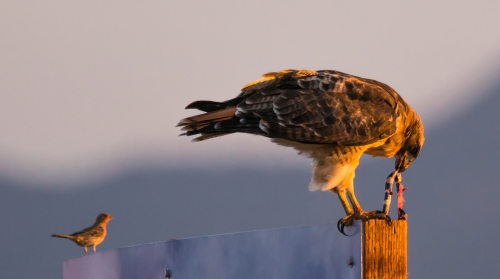
Rattlesnake Predators
Rattlesnake Predators That Are Immune to Rattlesnake Venom
Although they are venomous, Prairie Rattlesnakes do have some potential predators.
- One of these is the North American Racer. These snakes are immune to snake venom. They pin down their prey with their body and swallow it alive. Consequently, they are probably limited to very small rattlesnakes. North American Racers have been recorded eating rattlesnakes in the Black Hills.
- The non-venomous Western Milksnake’s coloration imitates that of venomous coral snakes. Western Milksnakes kill by constriction. They are immune to snake venom. Consequently, they sometimes prey on North Dakota’s Prairie Rattlesnakes.
- Skunks also prey on rattlesnakes. Fortunately for them, they are also immune to snake venom.
- Badgers also eat rattlesnakes and have some immunity to rattlesnake venom. In some states like North Dakota, badgers are the top predators of rattlesnakes.
- Feral hogs are also immune to snake venom and find rattlesnakes to be tasty snacks.
Rattlesnake Predators That Are Not Immune to Rattlesnake Venom
The following animals prey on rattlesnakes but are not immune to their venom. They have to manage to kill the snake without being bitten.
- coyotes
- bobcats
- mountain lions
- raptors
Rattlesnake Lookalikes in North Dakota
Bull Snakes
Bull Snakes are large, non-venomous snakes. The Bull Snake is the largest snake in North Dakota. They are capable of being 8 feet (2.43 M) long. People often mistake bull snakes, which are also called gopher snakes, for rattlesnakes. This is primarily because they are similarly marked. Bull snakes can do a pretty fair rattlesnake impression when they’re agitated. They do this by coiling in a defensive posture and flattening their heads. They even vibrate their tails sometimes. The best way to differentiate between a bull snake and a rattlesnake is to observe the tail. Bull snakes don’t have a rattlesnake’s rattle. Instead, their tail comes to a fine point.
Plains Hog-Nosed Snake
North Dakota is also home to the Plains Hog-nosed snake. The Plains Hog-nosed snake is a rear-fanged colubrid snake and is mildly venomous. However, they are not dangerous to humans.
Plains Hog-nosed snakes are also called Western hog-nosed snakes or blow snakes. They are relatively short and stout-bodied. Their color pattern is variable. But most morphs of this snake resemble a rattlesnake in coloration.
These snakes flatten their heads, hiss, and vibrate tails like rattlesnakes when threatened. They also may bluff strike without opening their mouths. This is more like a headbutt than a strike. As a last resort, they play dead.
Avoiding Snake Bite
Snakes, including venomous ones, commonly rely on their camouflage to avoid potential threats. They often remain perfectly still to avoid detection. If you’re walking in the woods and unknowingly get too close, a snake might not move, hoping you’ll pass by. This is particularly true of copperheads. Many bites happen when someone accidentally steps on or close to the snake. To stay safe in snake habitats, always watch where you step and where you place your hands.
Another common cause of snake bite is attempts to capture or kill a snake. Remember, venomous snakes can strike instantly, delivering a potentially life-threatening bite. The safest approach is to keep a safe distance and leave them alone.
Dressing for Snake Country
- High-top leather boots and long pants are both wise ideas.
- Also, wear loose-fitting denim. If there’s a gap before the snake’s fangs touch your skin, your chances of being envenomated are lower.
- In the absence of high-top leather boots, some people wear snake gaiters.
Symptoms of Rattlesnake Bites
Some of the symptoms you may experience from a venomous snake bite include:
- Discoloration in the area of the bite.
- Swelling in the area of the bite.
- Loss of muscle coordination.
- Tingling sensation in the area of the bite.
- Feeling nauseous.
- Having an abnormally rapid pulse.
What Should You Do If A Venomous Snake Bites You?
If you or someone you are with has suffered a venomous snakebite, time is of the essence. This is because the sooner a victim receives anti-venom, the less likely the venom in their body is to cause harm. In other words, it is important to seek immediate medical treatment.
Do not attempt to kill the snake for identification purposes. This gives the snake a chance to bite you again. Also, consider that severed snakeheads can still bite and envenomate. If you have a phone, the best thing you can do is take a picture of the offending reptile. Otherwise, get started on your way to the hospital.
First Aid for Snake Bite Victims
- Remain calm and limit your movements. Do not run. If you must hike back to a vehicle, do it calmly and deliberately. Put as little stress on your heart as possible.
- Keep the area of the snake bite below the heart level and never above the heart level. Keeping the bite below the heart level will reduce the venom’s flow. However, holding the bite above your heart level will increase the venom’s flow.
- Remove all constricting items such as bracelets, watches, or rings before swelling occurs.
- Remember that using a cold compress on a venomous snake bite is not advisable. The cold may cause the local blood vessels to constrict and spread the venom faster.
- You can wash the affected area like any other wound with soap and water.
- You may cover the bite area with a moist dressing to reduce the swelling.
- Get medical help as soon as possible. Call the hospital to tell them a venomous snake has bitten you. So they can have anti-venom ready to give you when you arrive.
- A person whom a venomous snake has bitten may go into shock. If this happens, lay them flat and cover them with a blanket.
Prairie Rattlesnakes in North Dakota play a crucial role in the ecosystem. They do this by keeping rodent populations in check and contributing to the natural balance in their habitats. While their presence may seem intimidating, understanding their behaviors and how to coexist with them can significantly reduce the risk of conflict.
When exploring North Dakota’s great outdoors, staying aware of your surroundings, wearing appropriate protective clothing, and respecting wildlife are key to safety. By leaving rattlesnakes undisturbed and appreciating their ecological importance, you can enjoy the beauty of nature without unnecessary risks.
Venomous snake bites are rare, and proper first aid and quick medical attention can mitigate severe outcomes. With knowledge and a cautious approach, you can confidently share the environment with Prairie Rattlesnakes while respecting their rightful place in North Dakota’s wild landscapes.
Recent Posts
The only venomous snakes in Washington State are Northern Pacific Rattlesnakes. The Northern Pacific Rattlesnake (Crotalus oreganus oreganus) is a sub-species of the Western Rattlesnake. Anyone...
Skunks are not classified as true hibernators. But they go into a state of torpor when the weather gets cold. Skunks are light sleep hibernators, along with opossums, bears, and raccoons. ...

